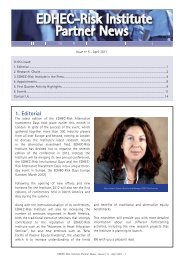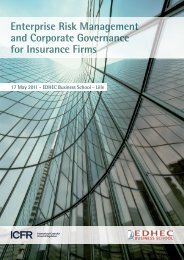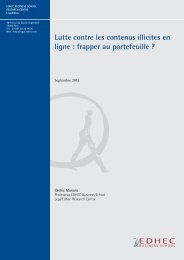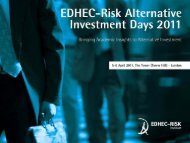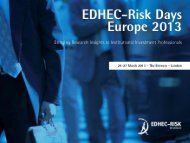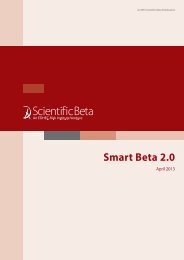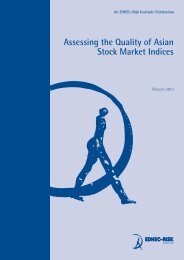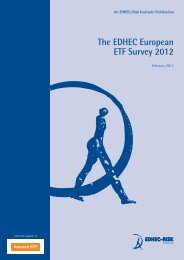Smart Beta 2.0 - EDHEC-Risk
Smart Beta 2.0 - EDHEC-Risk
Smart Beta 2.0 - EDHEC-Risk
Create successful ePaper yourself
Turn your PDF publications into a flip-book with our unique Google optimized e-Paper software.
2. Controlling the <strong>Risk</strong>s of <strong>Smart</strong> <strong>Beta</strong> Investing:<br />
The <strong>Smart</strong> <strong>Beta</strong> <strong>2.0</strong> Approach<br />
covariance parameters; on the other hand,<br />
it does not involve any optimality risk since<br />
the target portfolio would coincide with<br />
the true optimal portfolio in the absence<br />
of estimation risk.<br />
In this context, it is useful to first propose<br />
an empirical analysis of optimality risk taken<br />
in isolation, i.e., in the absence of any<br />
estimation risk. To conduct this analysis, we<br />
consider a large number of possible equity<br />
universes, defined in terms of many different<br />
possible reasonable true population values<br />
for risk and return parameters, and measure<br />
the difference for these parameter values (in<br />
terms of ex-ante Sharpe ratios, i.e., based<br />
on true parameter values) between the<br />
true MSR portfolios and various heuristic<br />
portfolios, as well as various combinations<br />
of these portfolios (see Martellini, Milhau<br />
and Tarelli (2013) for more details). We then<br />
analyse the distribution of this distance<br />
across all possible sets of parameter values<br />
so as to generate an absolute assessment<br />
of optimality risk for various heuristic<br />
portfolios, as well as a relative assessment of<br />
optimality risk amongst competing heuristic<br />
portfolios. For example, this analysis allows<br />
us to answer questions such as what is<br />
the probability (across all tested parameter<br />
values) that the GMV portfolio is closer than<br />
the EW portfolio to the (true) MSR portfolio,<br />
hence allowing us to compare the optimality<br />
risk involved in EW versus GMV (or any other<br />
heuristic) benchmark.<br />
In a second step, estimation risk is<br />
introduced so as to help measure the<br />
distance of various heuristic benchmarks<br />
using imperfect estimates with respect to<br />
the true MSR portfolio. This analysis allows<br />
us to analyse the interaction between<br />
estimation risk and optimality risk, and<br />
allows us to answer questions such as the<br />
following: given realistic estimation errors<br />
in the covariance matrix and expected<br />
returns, what are the chances that an<br />
imperfectly estimated MSR, which suffers<br />
only from estimation risk (estimated MSR<br />
different from true MSR) will be closer<br />
to the true MSR portfolio in terms of<br />
ex-ante Sharpe ratios compared to an GMV<br />
portfolio (for example) which is subject to<br />
optimality risk (because the GMV portfolio<br />
is different from the true MSR portfolio)<br />
but to a lower amount of estimation risk<br />
(since it does not require any expected<br />
return parameters)?<br />
Overall, our analysis allows us to provide<br />
a detailed empirical assessment of total<br />
specific risk of smart beta benchmarks (in<br />
terms of differences in ex-ante Sharpe<br />
ratios) between a given benchmark and the<br />
true MSR portfolio, by decomposing this<br />
specific risk as indicated in equation (1),<br />
which we rewrite as follows:<br />
Total distance (in terms of ex-ante Sharpe<br />
ratio based on true parameter values) of<br />
a given benchmark with respect to the<br />
true MSR portfolio = distance of the given<br />
target benchmark with respect to the true<br />
MSR portfolio assuming away estimation<br />
risk (optimality risk in the absence of<br />
estimation risk) + distance between the<br />
imperfectly estimated target and the true<br />
target (estimation risk).<br />
This analysis can also be used to manage<br />
specific risks of smart beta benchmarks. In<br />
particular, one may seek to have a strategic<br />
exposure to various smart beta benchmarks<br />
so as to diversify away these risks. For<br />
example, Exhibit 13 below shows the<br />
average Sharpe ratio across 2,226 different<br />
sets of reasonable parameter values for<br />
the S&P 500 universe. 23 This exhibit shows<br />
that assuming that true covariance and<br />
expected returns parameters are known,<br />
an exceedingly large value of 13.3377 is<br />
generated for the average Sharpe ratio of<br />
the maximum Sharpe ratio portfolio.<br />
23 - To generate realistic parameter values, we use the following approach. We elect to perform the analysis on weekly data over a 2-year rolling window, where we choose<br />
the rolling step to be equal to one week. For each position of the time-window considered, we take into account all stocks belonging to the universe, without introducing<br />
a survivorship bias. We then calculate a robust estimator. We use an implicit multi-factor approach, where principal component analysis is used to extract the factors and<br />
where random matrix theory is used to select the number of relevant factors. As far as the expected excess returns are concerned, we use expected returns implied by the<br />
Fama-French three-factor model.<br />
21




